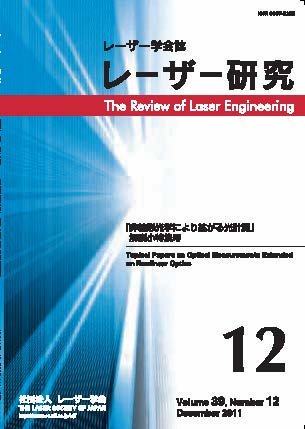All issues

Current issue
Special Issues on Advanced and Highly Reliable Optical Communication Accelerated by the Progress of Machine Learning
Displaying 1-7 of 7 articles from this issue
- |<
- <
- 1
- >
- >|
Special Issues on Advanced and Highly Reliable Optical Communication Accelerated by the Progress of Machine Learning
Special Issue
Laser Review
-
[in Japanese]2021 Volume 49 Issue 12 Pages 646-
Published: 2021
Released on J-STAGE: April 12, 2024
JOURNAL FREE ACCESSThis paper describes an overview of special issues for research and development on advanced and highly reliable optical communication accelerated by the progress of machine learning. The topics of these issues cover the following wide range: compensation of optical fiber nonlinearity, real-time and autonomous network diagnosis, monitoring techniques of optical devices, secure data-sharing networks, device design with neural networks, and optical machine learning by silicon photonics.View full abstractDownload PDF (271K) -
[in Japanese]2021 Volume 49 Issue 12 Pages 648-
Published: 2021
Released on J-STAGE: April 12, 2024
JOURNAL FREE ACCESSWe introduce our studies on optical nonlinearity compensation schemes that are based on machine learning technology for optical communication systems. We examine the performance of nonlinear equalization using an artificial neural network (ANN) by comparing our scheme with others, including a support vector machine (SVM) and the Volterra series transfer function (VSTF). We describe an SVM-based nonlinear equalizer and our improved version. We also discuss the problem of the computational complexity of a conventional VSTF-based nonlinear equalizer and introduce our investigation for improving VSTF’s computational complexityView full abstractDownload PDF (525K) -
[in Japanese]2021 Volume 49 Issue 12 Pages 653-
Published: 2021
Released on J-STAGE: April 12, 2024
JOURNAL FREE ACCESSAn optical transmission link is generally composed of optical fibers, optical amplifiers, and optical filters. These optical components are conventionally monitored by analog measurement instruments such as an optical time domain reflectometry and an optical spectrum analyzer. We review recent studies that attempt to extract these components’ characteristics only from digital signal processing of data-carrying signals in a system identification manner. The key is to leverage the similarity between structures of the split-step Fourier method for the nonlinear Schrödinger equation and neural networks. By combining these existing model and data-driven approach, we have demonstrated a monitoring method that extracts longitudinal distributions of optical components’ characteristics such as optical fiber loss/dispersion profiles, gain spectra of multiple optical amplifiers, and responses of multiple optical filters without any analog measurement devices. This approach will thus facilitate automated establishment and management of optical networks.View full abstractDownload PDF (893K) -
[in Japanese], [in Japanese]2021 Volume 49 Issue 12 Pages 660-
Published: 2021
Released on J-STAGE: April 12, 2024
JOURNAL FREE ACCESSWe present an autonomous real-time network diagnosing platform toward network operation automation. The platform consists of four functions: network monitoring, analyzing, deduction, and modeling. We discussed two PoC demonstrations, including a novel optical fiber bending detection using digital coherent detection with machine learning and autonomous network protection that utilizes fiber-bending information.View full abstractDownload PDF (1695K) -
[in Japanese], [in Japanese]2021 Volume 49 Issue 12 Pages 671-
Published: 2021
Released on J-STAGE: April 12, 2024
JOURNAL FREE ACCESSFocusing on nanophotonic power splitters, we show that a new class of generative neural network, so called an adversarial conditional variational autoencoder with cycle consistency, can design a series of devices that achieve nearly arbitrary target performance, with an excellent capability to generalize training data produced by the adjoint method. This method is generic and is expected to be applicable to a broad range of design problems, not limited to nanophotonics.View full abstractDownload PDF (707K) -
[in Japanese]2021 Volume 49 Issue 12 Pages 676-
Published: 2021
Released on J-STAGE: April 12, 2024
JOURNAL FREE ACCESSArtificial intelligence based on deep learning has developed drastically in the past decade, requiring more computing capability. However, the saturation in Moore’s law is expected in the next decade, promoting research for new computing technologies which do not rely on Moore’s law. A deep learning accelerator based on a Si programmable photonic integrated circuit (PIC) is one of the promising computing technologies. After the first demonstration in 2017, many proposals of optical neural network using Si photonics has been reported. To program a programmable PIC, an optical phase shifter is a key device. Currently a thermo-optic phase shifter is used in a programmable PIC, while its power consumption is too high for large-scale integration. To resolve this issue, we have investigated a hybrid metal-oxide semiconductor (MOS) optical phase shifter enabling an ultralow-power programmable PIC. We have also proposed a Si microring crossbar array which enables on-chip inference and learning.View full abstractDownload PDF (1358K)
Laser Original
-
[in Japanese], [in Japanese], [in Japanese], [in Japanese], [in Japane ...2021 Volume 49 Issue 12 Pages 682-
Published: 2021
Released on J-STAGE: April 12, 2024
JOURNAL FREE ACCESSWe present novel network diagnosing method to enable simultaneous detection of optical fiber bending diameter and its longitudinal length. The proposed method is based on co-operation of CAT autonomous network diagnosing platform and multiple wavelength OTDR. We have successfully confirmed the method experimentally at bending diameters of 20 and 15 mm by using the measured data from OTDR at 1550 and 1625 nm in wavelength.View full abstractDownload PDF (823K)
- |<
- <
- 1
- >
- >|